Tomatoes are widely cultivated worldwide, and several hundred varieties are available. Tomatoes come under the fruits category and are rich in lycopene and Vitamin C. It provides various nutrients and many health-related benefits to the human body. Tomatoes are used in various ways. Ripe tomatoes are consumed fresh and fried or used in cooking.
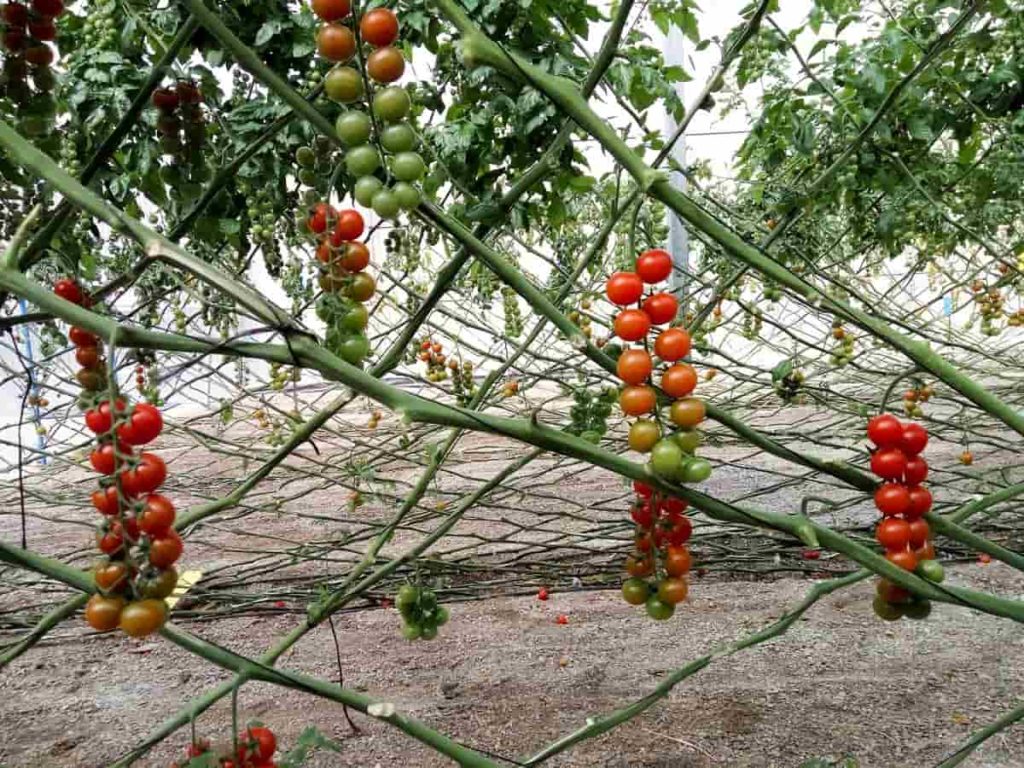
They are also sundried or processed into tomato sauce, puree, powder, soup, or canned tomatoes, chutney, and jam. They are an important ingredient in most cooked meals. Tomatoes are also consumed raw in salads. Tomato production will improve the livelihoods of small-scale producers by creating work and serving as a source of income for rural and urban dwellers.
A tomato plant is well known for its high productivity and rapid growth in Africa. Many tomato varieties are growing in Africa by adopting the latest cultivating methods to get a great harvest. Tomatoes are one of the vegetable fruits with the highest consumption in Africa. This farming guide will outline how to start tomato farming in African countries.
How to start Tomato farming in Africa
Tomato varieties
There are tons of types of tomatoes. They are very versatile vegetables, with giant beefy types that can cover an entire sandwich while remaining sweet as candy. They also have tiny little cherry types that deliver that satisfying sour pop when they first ripen. Based on size and shape, tomatoes are categorized into five basic types.
Standard Globe Tomatoes (Regular-Sized Slicer Tomatoes)
It is a classic tomato type, usually called salad tomatoes. These are 2 to 3 inches wide with a more tart, acidic taste. These tomatoes are perfect for slicing and eating raw but can also be cooked into a sauce or stuffed with breadcrumbs. The common varieties include Alicante, better boy, bodacious, bucks county, celebrity, and Early girl tomatoes. These high-yielding plants often bear fruit in just 55 to 65 days, with some ready for harvest in 45 days.
Beefsteak Tomatoes (Large Slicer Tomatoes)
Beefsteak tomato plants will grow up to six feet tall and produce big tomatoes that often weigh more than one pound. A beefsteak tomato plant is one of the largest tomato-producing plants, producing fruits that expand up to six inches in diameter. Many beefsteak tomato types take at least 85 days to harvest. The common varieties include Brandywine, Bucking Bronco, Cherokee purple, Marmande, and mortgage lifte.
Cherry Tomatoes (Mini Tomatoes)
Cherry tomatoes taste sweet and look small. They grow in clusters and are very easy to grow, being disease and drought-resistant. These tomatoes are widely used for salads for flavorful perfection. The common varieties include black cherry, yellow pear, sweetie red, tumbling tom red, and tumbling tom red stripe. Cherry tomatoes are typically ready for harvesting within around 50 to 65 days after planting.
In case you missed it: Tomato Farming Guide for Beginners: Production Techniques, Process, and Steps

Plum Tomatoes (Paste Tomatoes)
Plum tomatoes are one of the classic tomatoes used for making sauces, juice, and tomato paste. They are also called processing or paste tomatoes and have oblong fruits, often with blunt or pointed ends. Plum tomatoes are essential in tomato sauce because they have less liquid than slicing types of tomatoes. The common varieties include san Marzano, speckled roman, sunrise sauce, red grape, and Ukrainian purple. After transplanting, you will see the fruit appear within 65 to 70 days.
Oxheart Tomatoes (Heart-Shaped Tomatoes)
These tomatoes are appropriately named for their shape and size, and these oxheart varieties produce fruit weighing up to three pounds. These tomatoes are meaty with few seeds, making them a great slicing tomato. Most oxheart tomatoes will take 70 to 90 days to harvest. Livingston’s Giant, Upstate, Dwarf Purple, and Livingston’s yellow are the common varieties of oxheart tomatoes.
Preparation of the seed for the tomato plant
The foremost step for growing tomatoes is to prepare the seed beds. The tomatoes will sprout within a week of sowing if the minimum temperature exceeds 12ºC. If the temperature falls below this temperature, the seeds will stop growing. So it is very important to protect the seed pads from low night temperatures.
And also, Maintain stable humidity for good seed germination. About 400-500 grams of seed are sufficient for raising seedlings for one hectare of land. Before sowing, seeds are treated with fungal culture to avoid damage from the damping-off disease. Sowing should be done in rows spaced at a 10-15 cm distance.
Soil requirement and preparation for tomato farming
Tomatoes can grow well in well-drained loam soils with a pH range of 5 to 7.5. The soil condition for planting tomatoes should be slightly acidic. If the soil is too acidic, then adjust it by adding lime. On the other hand, amend an alkaline soil by adding sulfur to lower the pH; it will take a couple of months for the pH of the soil to adjust. Avoid planting tomatoes on the sand lands. Keep the soil in warm condition by covering it with plastic sheets. Not only getting it warm but also the plastic traps enough heat to kill insect larvae and diseases in the soil.
In case you missed it: How to Start Tomato Farming in Philippines: A Useful Growing Guide for Tomato Farmers
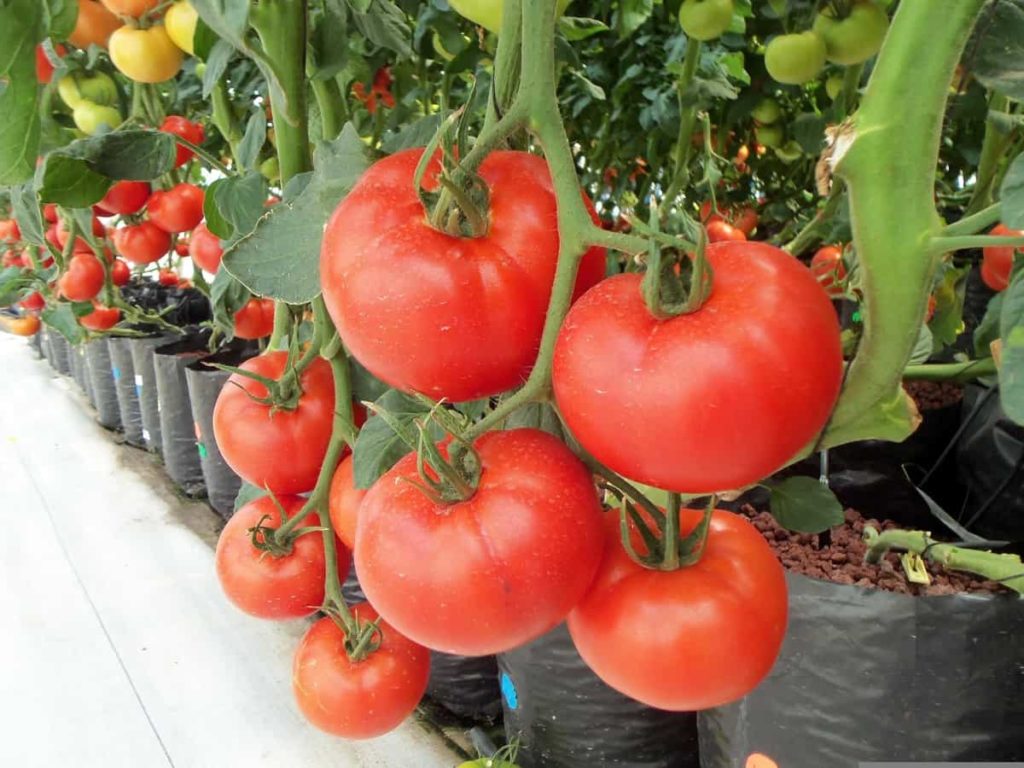
Preparing seed beds
Tomatoes will grow better when transplanted from a seedbed. They perform better when planted in trays. Good seedbed preparation ensures good plant establishment and strong growth. Seedbeds are usually prepared by raising soil around 15 cm high and leaving spaces for walkways around 30 cm or more between beds. The soil should be tilled by plowing. This plowing makes it easier for the small seeds to break through the soil.
Soak the seeds in a mixture of plant growth stimulant and fungicide solution for 4 minutes before sowing as a precaution against nursery damping and to give them a boost. The seeds should not be buried very deeply into the soil but should be covered with a light layer of soil. Use your finger to draw the lines where you want to plant the seeds and cover them lightly with soil.
The spacing between rows should be around 15 cm. The bed is covered with dry grass to increase moisture level. This bed covering also reduces the splash effect during watering. Otherwise, after preparing beds for tomatoes, covering the soil with black plastic for a few weeks before planting is one way to get it warm.
Sowing the seeds on beds
Sowing should be done in rows spaced at a 10-15 cm distance. Seed sowing should be done at a depth of 2-3 cm and covered with a thin layer of soil, followed by watering by a watering can. The beds must be covered with dry grass or sugarcane leaves to maintain the required temperature and moisture.
Watering should be done in the morning. The seeds will be sprouted in 8-10 days. The watering should continue for one to two weeks before transplanting, where it is reduced to harden the seedlings. Seedlings will take one month before they are ready for transplanting. Monitor regularly for pests and diseases because the earlier they are spotted and treated, the better the survival rate.
Seedling care or maintenance
Seedling care is a very important part of getting healthy plants. No one will ever dream of a good harvest without healthy plants. In addition, they are more chances of getting affected by pests and diseases. Water properly, and do not let the bed dry out. Water them when needed, and watering every two days is recommended. Always water the tomato seedlings with chlorine-free water. Provide adequate sunlight in the morning at the seedling stage. But keep the seedlings in the shade throughout the day.
Transplanting the tomato plants
Open-field tomato cultivation is the most used method of farming tomatoes in Africa. Under this method, tomatoes are well grown in open fields under natural ecological conditions. The farmers using this method tend to rely on prevailing weather patterns to plant the crop. While this is so, drip irrigation can be used under this method to supplement rainfall or to farm in dry areas. Two days before removing seedlings from the bed, apply a plant growth stimulant to the seedlings.
This stimulant will ensure a faster recovery from transplant shock. When seedling stems are between 4-6 mm in diameter or about 1 foot high, transplanting should be done. Remove the seedlings from the seed bed after watering well. Place the bed trays in a shaded place, away from direct sunlight. Plant seedlings in holes and cover the roots with soil firming the soil around the roots. Water well but not excessively. Avoid planting weak and diseased plants. Plant the seedlings at a spacing of 45-60 cm. Dig the planting holes to 6 inches depth.
In case you missed it: Connecticut Vegetable Planting Calendar (CT): Month Wise, Fall, Winter, Spring, Summer, Zone 5, Zone 6, and Zone 7
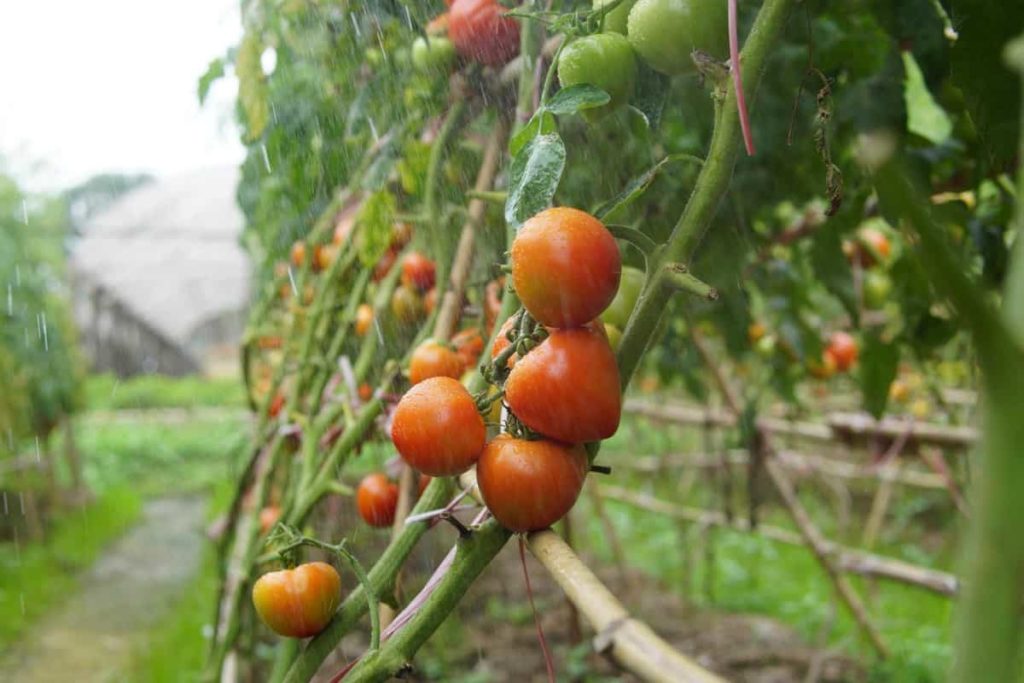
If you apply manure, carefully incorporate it into the soil before planting. Fertilize the soil with DAP fertilizer at 80kg per acre. Plant tomato plants deeper until the first leaves have been removed at an earlier stage. This deep planting will allow the roots to develop along all their stems. Grow the plant vertically, so the sun covers the plant roots openly on the ground. It is necessary to maintain soft moisture on the soil immediately after transplanting until the plants take root.
Irrigation and moisture management
Moderate droughts require appropriate management actions to manage the amount of yield and its quality. These management actions involve various aspects, such as water and moisture management and maintaining the appropriate aeration levels at the crop root. The excessive water supply in tomato cultivation removes the soil air content. Besides, excess moisture results in damping-off disease, root fungal, and soil-borne bacterial diseases.
Scheduling irrigation for tomatoes based on crop factors and evaporation, combined with moisture monitoring to confirm irrigation effectiveness, will result in more effective and efficient watering. Reduced pumping time results to lower input costs, higher returns, and better business and environmental outcomes. Irrigate the farm to keep the soil moist without being soggy or muddy.
An irrigation cycle of twice a week is usually sufficient for tomatoes. The tomato plants require more stable subtle watering. Let the plant take some stress to allow it to adapt and take root deep. Usage of padding leads to reduce water waste and loss of fertile soil. When creating tomato plants, always leave the roots underground to improve the soil and not remove the soil. It is best to build the substrate before planting to maintain good moisture distribution.
Control of weed growth
Weeds decrease yields by competing for space, light, water, and nutrients, weakening crop stand and reducing harvest efficiency. Some weeds will also increase pest problems by helping insects, diseases, or nematodes as hosts. Effective weed management in tomato farming involves crop rotation practices, proper field preparation, sanitation, irrigation management, and selection of herbicides.
In tomato production, many growers prepare beds in the fall to facilitate early spring planting; some beds may be treated with an herbicide. Herbicides can also be applied several weeks before planting, at the time, and after planting. Hand weeding is also implemented in many African countries to control weeds in tomato farms. To avoid competition with the tomatoes and to make removal easier, cultivate when weeds are small.
Fertilization in tomato farming
Tomatoes are heavy feeders that generally require fertilizer to get them through the season. The problem is figuring out which fertilizer is best, how much is required, and when to feed the plants. Tomato plants may not need fertilizer if you dig a generous amount of well-rotted manure into 8 to 12 inches of the top layer of soil at planting time. Manure should be nutrient-rich but low in phosphorus. If phosphorus content is more in manure, balance it out by adding a little bone meal along with the compost.
Some growers prefer a high-phosphorus fertilizer, indicated by a larger middle number. You can keep it simple with a fertilizer specially formulated for tomatoes. Most importantly, do not over-fertilize. The usage of too little fertilizer is always better than too much. During the flower set, apply a dose of liquid organic fertilizer high in fulvic acid and organic matter, targeting the flower buds.
You can also mix with soluble foliar fertilizers with high potassium and calcium. This organic fertilizer will avoid calcium end rot and other related fruit diseases later on and protect against flower/fruit abortion. After the flower set, avoid fertilizers that are rich in nitrogen. Furthermore, organic solutions and natural remedies eliminate and treat parasites and diseases.
Usage of mulch in tomato farming
Add mulch, a natural covering on top of the soil, to keep moisture in, block weeds and provide added nutrients. This mulching is useful on hot summer days, especially when the ground exceeds the tolerance level. Mulching helps to maintain soil moisture, protects the plant from hot temperatures, and keeps weeds away. Immediately after planting, mulch the around tomato plants with organic mulch. However, leave some areas near the stem so water can effectively enter the roots. Using mulches in tomato forming can results.
In case you missed it: Onion Farming in Tamilnadu: A Helpful Production Guide for Beginners
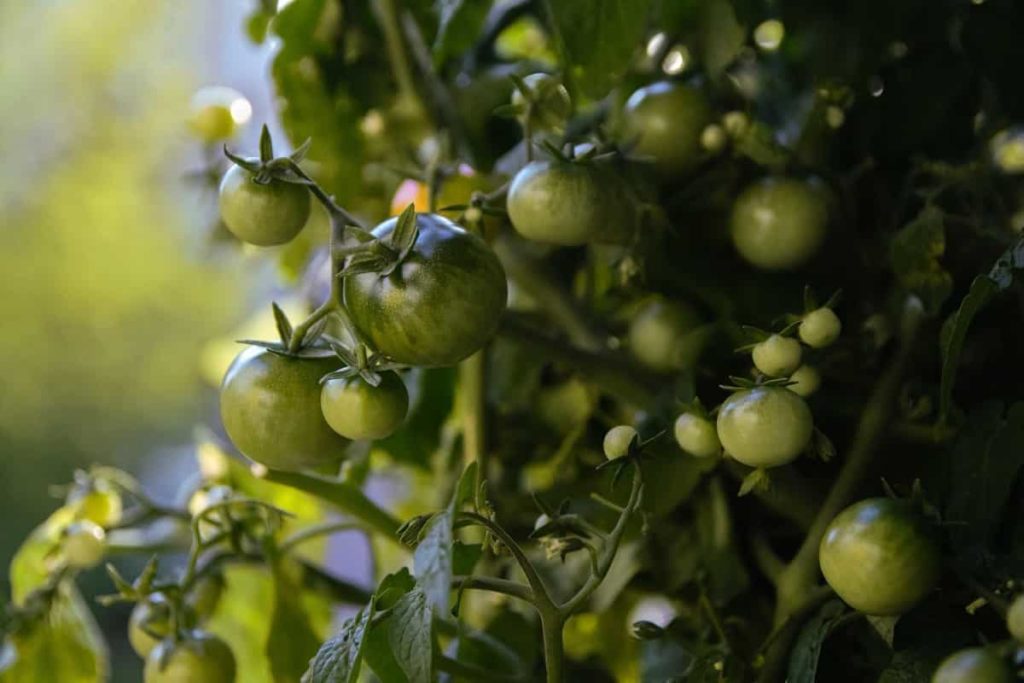
- Mulch protects the lowest-growing fruit from resting on the ground
- Mulches restrict weeds growth
- Mulch decreases water consumption as the mulch restricts the evaporation of moisture from the soil.
Pest and disease in tomato farming and their control
Tomato is a major vegetable in sub-Saharan Africa and is grown mainly as a cash crop. The crop can grow throughout the year; however, production is constrained by diseases and insect pests and by abiotic factors including low moisture stress, heat, and low soil fertility
Staking and pruning
Staking is done by tying a plant vertically using a string and poles. Another method generally seen is two poles are connected using a wire and plants suspended using strings tied to it. This method increases the productivity of tomatoes as compared to traditional open-air methods. The plants grow vertically, having several fruit clusters along the stem. Support should be provided early after transplanting when the plant is still young to avoid stem damage or breaking later.
Pruning is the process of removing side shoots, old leaves, diseased leaves, and laterals. Pruning indeterminate tomatoes increases fruit production by removing extra growth that diverts energy away from developing fruits. Removing extra growth redirects energy back to the fruits and reduces fruit shading, which will help fruits mature more quickly. Pruning should be done weekly to remove side shoots before they develop. Apply any growth stimulants after each pruning or staking to aid the plant recover from the shock.
Harvesting
The tomatoes will be ready for harvesting from the 70th day onwards, depending on the variety planted. Carefully remove the ripe fruits from the stems and place them in clean, disinfected containers ready for transport. Hold the fruit firmly but gently, and pull it from the plant by holding the stem with one hand and the tomato with the other, breaking the stalk just above the calyx that has formed to protect the bud.
Once the tomatoes are harvested, store them indoors to continue to ripen. Green tomatoes will ripen faster if wrapped in newsprint containing the ethylene gas and hasten the process. Store them at 13-21°C or cooler if you want to slow the ripening and warmer to hasten it and check routinely for ripeness. Tomatoes will last from three to five weeks stored this way.
Tomato farming in Kenya
The continued rise of the population of Kenya has directly contributed to the increasing demand for horticultural commodities such as tomatoes. Tomatoes are important in Kenyan diets as they are used in cooking many dishes. Tomatoes thrive in deep, well-drained soils in warm or hot climates; the crop requires much water to produce well. Most tomato farms in Kenya are located along rivers in Narok, Kajiado, Makueni, Southern Embu, Laikipia, and lower Kirinyaga.
Anna F1
It is one of the popular tomato varieties in Kenya. Anna F1 has an average tomato yield of 74 tons per acre and 35 kg per tomato plant in its life span.
Marglobe Tomato
Marglobe is one of Kenya’s earliest maturing tomato varieties, with an average maturation period of 67 days. This tomato crop yields up to 50 tonnes per hectare.
In case you missed it: Tomato Farming Guide for Beginners: Production Techniques, Process, and Steps
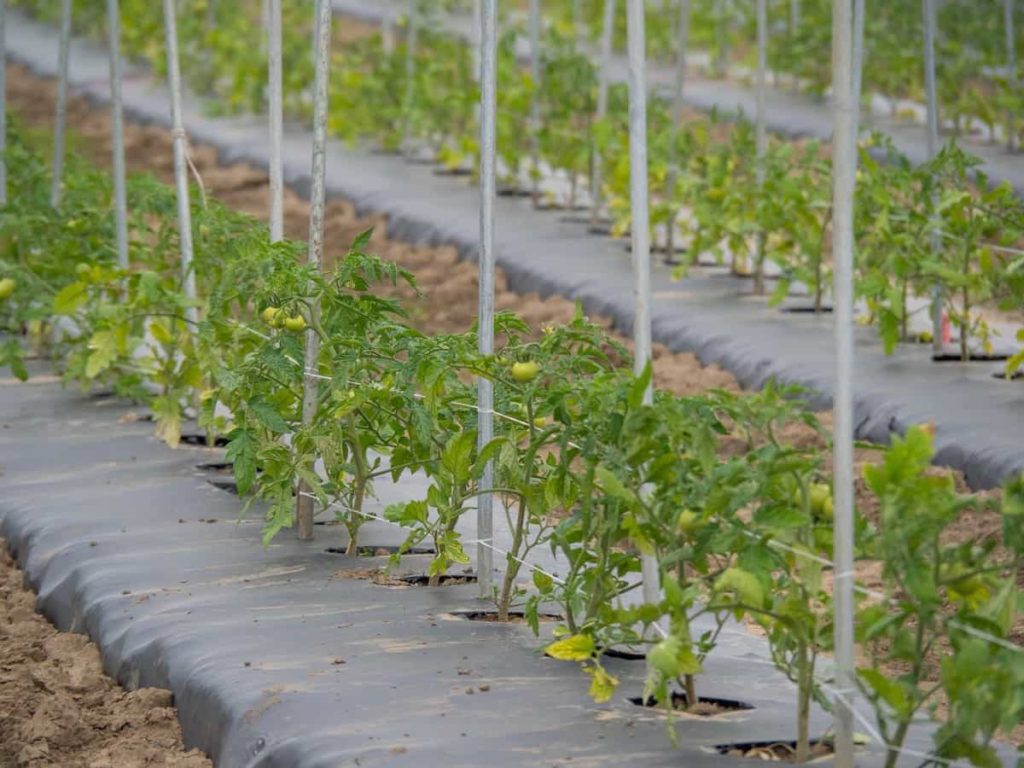
Tomato farming in Nigeria
In Nigeria, tomatoes are widely cultivated in the country’s northern states. Most states in the north, like, Jigawa, Plateau, Benue, Kaduna, Sokoto, Kebbi, Nasarawa, Zamfara, and Kogi, have huge tomato plantations. In Nigeria, the types of tomatoes are categorized by their shapes, local names, and cultivation location.
Yoruba, Hausa, and Beske are the common varieties grown in Nigeria. In Nigeria, most tomato farmers, especially the small-scale ones who do not implement good agronomic practices, get a yield of about 2-5 tonnes per acre. The Nigerian tomato farmers that use drip irrigation and practice good agronomic practices get up to 25 tonnes per acre.
Tomato farming in Egypt
Egypt is currently one of the world’s top tomato producers, ranking fifth globally, but it exports less than one percent of its crop yearly. Egypt produces about 8 million tonnes of fresh tomatoes annually, making it the world’s fifth-largest producer. The country’s suitable climate, dual seasonality, and fertile lands are the reason for the high productivity.
Luxor is becoming the main hub for sun-drying tomatoes in Egypt. Luxor, a city approximately 650km from Cairo, produces a third of Egypt’s tomato crop of eight million tonnes. Cherry tomato varieties are widely cultivated in Egypt, and this tomato corp will yield up to 30 tonnes per acre.
Tomato farming in South Africa
The tomato farming business is a highly profitable venture to start in South Africa. The demand is incessantly high as tomatoes are needed daily for incorporation into things like stews, soups, and salads, among many others. Tomatoes are grown in soil with lime or high calcium; otherwise, the fruit itself may split.
A large variety of tomatoes are cultivated in South Africa. Cherry varieties like black cherry, yellow pear, sweetie red, and tom red are cultivated. And also, large-size tomato varieties, including golden jubilee, green zebra, Heinz, big rainbow, purple Cherokee, and black Krim, are widely grown in South Africa
Tomato farming in Ethiopia
Tomato is widely cultivated and planted in Ethiopia. Indifferent places, seasons, soils, weather conditions, technology, and output level, ranking fourth in annual total national vegetable Tomato is the most vital vegetable in Ethiopia. Tomatoes in Ethiopia are mainly produced in the northern and central rift valley areas. Average productivity of 9.4 tons of tomatoes is cultivated in Ethiopia per hectare. In general, the average productivity of tomatoes in Ethiopia is too low compared with the world other African countries average productivity of 38.3 tons per hectare
Tomato farming in Zambia
Tomato is one of Zambia’s most consumable vegetable crops grown commercially and on a small scale. The highest yields are obtained in the dry season under irrigation. On the other hand, the lowest yield is during the rainy season, from October to March. Roforto and Herald yielding 40 tonnes per hectare were the best, while Harvester tomato variety, with 31 tonnes per hectare, was the lowest under the prevailing meteorological conditions.
- Profitable Village Farming Business Ideas in 2024
- High-Yield Aquaculture: Fast-Growing Fish for Farming
- Effective Fish Pond Construction Techniques for Beginners
- Irrigation and Water Management in Pineapple Farming
- Blossom to Harvest: Mastering Flowering and Pollination in Papaya Farming
- Pig Fattening Essentials: From Selection to Sale for Beginners
- Raising Wagyu Cattle: A Complete Guide for Premium Beef Production
- Soil Types and Their Water Holding Capacity
- Optimizing Irrigation Schedules for Coconut Groves for Enhanced Yield
- Espresso Your Garden: Coffee Grounds for Healthier Acid-Loving Plants
- The Best Soil Mix for Snake Plants: How to Mix Your Own Snake Plant Soil
- Green Thumb Success: Expert Tips for Cultivating Greenhouse Beans All Year Round
- Bloom All Year Round: The Ultimate Guide to Indoor Hyacinth Care
- Eco-Friendly Gardening: How to Make Liquid Fertilizer from Kitchen Waste
- Ultimate Guide to Grow Anise in Pots: Explore Seed Propagation to Harvesting
- Guide to Raising Chester White Pigs: Discover Breed Facts to Growth Management
- Mastering the Elegance: The Ultimate Guide to Weeping Cherry Tree Care, Planting, and Maintenance
- Ultimate Guide to Planting Garlic in Grow Bags: Growing Strategies for Beginners
- How to Fix Spider Plant Leaf-Related Problems: Natural and Organic Remedies
- 10 Reasons Why Your Tulsi Plant is Shedding Leaves: Home Remedies and Solutions
- Optimizing Growth and Yield: The Advantages of Palm Bunch Ash Fertilizer
- Utilizing Neem Oil Extract as a Natural Pesticide for Hydrangea
- From Soil to Harvest: Various Ways in Which Farmers Can Use AI Tools
- Steps to Encourage and Induce Citrus Flowers: A Comprehensive Guide
- How to Fix Snake Plant Leaf-Related Issues: Natural and Organic Remedies
- Transform Your Garden into a Fragrant Oasis with Raat Ki Rani (Night Blooming Jasmine)
- Discover the Ideal Chicken Breeds for Philippine Farms
- How to Create a Poultry Egg Farm Business Plan for Profits
- Grow Lemon Cucumbers Like a Pro: Insider Techniques for Bountiful Yields
- Ultimate Guide to Caring for Your Pink Princess Philodendron: Tips for Thriving Variegation
- Areca Nut Profit Per Acre: Calculating Yield and Cost of Cultivation
- How Kaveri Chicken is Becoming a More Profitable Breed in Indian Backyards
- Transform Your Barn: 9 Steps to Convert a Horse Stall into a Chicken Coop
- Exploring Suffolk Sheep Disadvantages with Limitations and Challenges
- Guide to Solving Potted Lemon Tree Problems: How to Revive Lemon Tree in Containers
- Steps to Encourage Female Pumpkin Flowers: Best Strategies for More Flowers and High Yields
